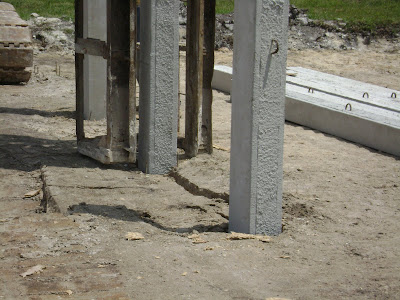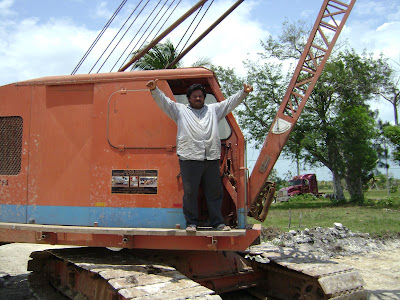
 John Harris and Zane, the owner of the piling company.
John Harris and Zane, the owner of the piling company.  Cutting the piles down to size.
Cutting the piles down to size.



Watching piles being driven is like watching paint dry... not very exciting. Or at least that's the way you want it to be. And the shaking of the ground was almost non-existant. From Pip and Jasons' place, next door, you couldn't tell there were piles being driven. No ground movement at all.

As it gets closer to the end of the day, the last two piles are left to be driven. It's almost over. Or so I thought. The last in a series of piles that had all been driven down about 30 feet, we were going to sink a 40 footer. That would leave about 10 feet of piling, exposed above ground. And that would be cut to 3 feet with the top 1 foot of concrete broken off to expose the steel strands just like the others in the previous pictures. But watching them drive this pile was different. After the first 3 or 4 feet of topsoil, the pile dropped 6 feet in one pounding. The next pounding, another 4 feet disappeared. Ten feet in two poundings. We are now down 15 feet and sinking fast. But, if the results are the same as the previous pilings in this row, the resistance should start at about 25 feet and stiffen up at around 29-31 feet, just like the six more before in the same area.




Unfortunately, this was not to be the case this time. The pile driver kept driving, and our pile kept sinking. 20, 25, 30 feet went by, just like that. The other piles were now at the same height, but this 40 foot pile had more to go. 35 and now 40. The pile driver now has the piling at ground level. And still has more to go. Then we find the cavern.

The pile driver has now pounded this 40 foot pile, 44 feet in the ground. It is at this point that the piling has finally met stiff resistance. Four feet below gound level we found an open cavern that was large enough to probably stand inside. Phil has given his OK to stop driving the pile.






Cutting the piling to expose the rebar, below ground level.
John will form up a cast with rebar and type 1 cement to bring this post up to the correct height. He said it's not a problem to do this. So that will be done another day. We have finished driving piles. And that's a good thing. We may fill in a portion of the cavern, but there is no need to crush and fill it all. That's why we went with the pilings. It turned out to be a wise decision.

Everyone is happy that the pile driving is done!


2 comments:
Hello, I am looking for a company to install pilings in Placencia, Who did you use for a soils eng. also the company that installed them? What was your cost per pilling? Thank you for your help on info as this is half the battle
Cheers
Brent
Hi Brent,
I'm sure there are places in Belize City or Placencia that do pilings. We used Sealander, out of Orange Walk. I can provide more details if you are interested in talking to them. I used a soil engineer from the community we live in, so he knew what to expect. You might want to find a local outfit that has knowledge of the area. I'm sure that with all the construction going on down there, there's bound to be someone driving pilings. You also might want to check with the CBA (Central Building Authority) to see what they have approved in the area you're planning to build on. As for the cost per piling, it depends a lot on the size (30', 35' 40', etc.) of the piling, the distance from the company site to your site (cost to deliver the pilings and the pile driver) and the amount of pilings to be driven. A rough estimate would be $400-$500 US per piling, delivered and driven.
Post a Comment